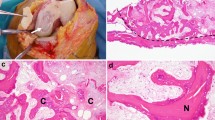Summary
Seventeen patients with haematogenous osteomyelitis and long diaphyseal sequestra are reported. Treatment was incision and drainage with antibiotics for at least 6 to 8 weeks, the limb being protected in plaster for a long time. The sequestra became incorporated in every case. Sequestrectomy should only be undertaken when successive radiographs show no reduction in size of the sequestrum and an increase in the amount of the involucrum.
Résumé
Etude de 17 patients, le plus jeune âgé de 7 mois et le plus vieux de 20 ans porteurs d'une ostéomyélite hématogène avec grande séquestration diaphysaire. L'incorporation du séquestre diaphysaire sera finalement obtenue dans tous les cas. Nous pensons que l'ostéomyélite hématogène chronique avec séquestration diaphysaire doit être traitée avec une intervention chirurgicale à minima sous forme d'incision et de drainage et d'un traitement antibiotique (de 6 à 8 semaines initialement et éventuellement répété selon l'évolution) et d'une immobilisation plâtrée de longue durée. L'indication de séquestrectomie sera posée seulement si la surveillance radiologique ne montre pas de réduction en taille du séquestre et une augmentation de l'involucrum.
Similar content being viewed by others
References
Bosworth DM, Liebler WA, Nastasi AA, Kunikata H (1966) Reaction of the tibial shaft for osteomyelitis: a 32 year follow up study. J Bone Joint Surg [Am] 48: 1328–1339
Daoud A, Saighi-Bouaouina A (1989) Treatment of sequestrum: pseudarthroses and defects in long bones of children who have chronic haematogenous osteomyelitis. J Bone Joint Surg [Am] 71: 1448–1468
Eyre-Brook AL (1984). The periosteum: its function reassessed. Clin Orthop 189: 300–307
Fowles JV, Lehoux J, Zlitni M, Kassab MT, Nolan B (1979) Tibial defects due to acute haematogenous osteomyelitis: treatment and results in 21 children. J Bone Joint Surg [Br] 61: 77–81
Huckstep RL (1968) The management of osteomyelitis in East Africa. E African Med J 54: 429–446
Lauschke FHM, Frey CT (1994) Hematogenous osteomyelitis in infants and children in the north-west region of Namibia. J Bone Joint Surg [Am] 76: 502–510
Tronzo RG, Dowling JJ (1962) Acute hematogenous osteomyelitis of children in an era of broad spectrum antibiotics: a comprehensive review. Clin Orthop 22: 108–123
Verma BP, Tuli SM, Srivastava TP, Mohindra YD (1984) Reincorporation of early diaphyseal sequestra and bone remodelling in extensive hematogenous osteomyelitis in children. Indian J Orthop 8: 39–44
Author information
Authors and Affiliations
Rights and permissions
About this article
Cite this article
Jain, A.K., Sharma, D.K., Kumar, S. et al. Incorporation of diaphyseal sequestra in chronic haematogenous osteomyelitis. International Orthopaedics 19, 238–241 (1995). https://doi.org/10.1007/BF00185230
Accepted:
Issue Date:
DOI: https://doi.org/10.1007/BF00185230




